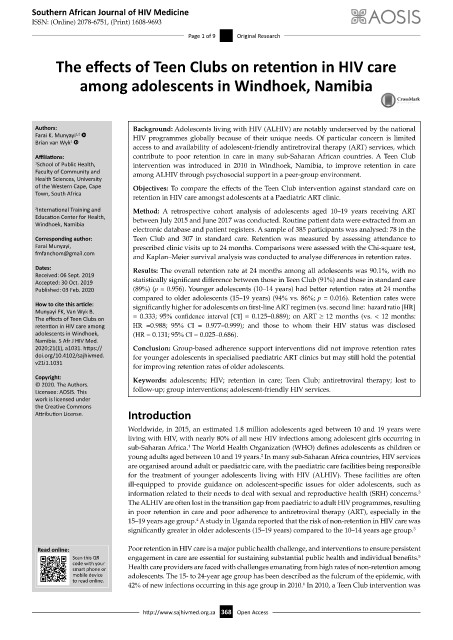Page 376 - HIVMED_v21_i1.indb
P. 376
Southern African Journal of HIV Medicine
ISSN: (Online) 2078-6751, (Print) 1608-9693
Page 1 of 9 Original Research
The effects of Teen Clubs on retention in HIV care
among adolescents in Windhoek, Namibia
Authors: Background: Adolescents living with HIV (ALHIV) are notably underserved by the national
1,2
Farai K. Munyayi HIV programmes globally because of their unique needs. Of particular concern is limited
Brian van Wyk 1
access to and availability of adolescent-friendly antiretroviral therapy (ART) services, which
Affiliations: contribute to poor retention in care in many sub-Saharan African countries. A Teen Club
1 School of Public Health, intervention was introduced in 2010 in Windhoek, Namibia, to improve retention in care
Faculty of Community and among ALHIV through psychosocial support in a peer-group environment.
Health Sciences, University
of the Western Cape, Cape Objectives: To compare the effects of the Teen Club intervention against standard care on
Town, South Africa
retention in HIV care amongst adolescents at a Paediatric ART clinic.
2 International Training and Method: A retrospective cohort analysis of adolescents aged 10–19 years receiving ART
Education Center for Health, between July 2015 and June 2017 was conducted. Routine patient data were extracted from an
Windhoek, Namibia
electronic database and patient registers. A sample of 385 participants was analysed: 78 in the
Corresponding author: Teen Club and 307 in standard care. Retention was measured by assessing attendance to
Farai Munyayi, prescribed clinic visits up to 24 months. Comparisons were assessed with the Chi-square test,
[email protected]
and Kaplan–Meier survival analysis was conducted to analyse differences in retention rates.
Dates: Results: The overall retention rate at 24 months among all adolescents was 90.1%, with no
Received: 06 Sept. 2019
Accepted: 30 Oct. 2019 statistically significant difference between those in Teen Club (91%) and those in standard care
Published: 03 Feb. 2020 (89%) (p = 0.956). Younger adolescents (10–14 years) had better retention rates at 24 months
compared to older adolescents (15–19 years) (94% vs. 86%; p = 0.016). Retention rates were
How to cite this article: significantly higher for adolescents on first-line ART regimen (vs. second line: hazard ratio [HR]
Munyayi FK, Van Wyk B.
The effects of Teen Clubs on = 0.333; 95% confidence interval [CI] = 0.125–0.889); on ART ≥ 12 months (vs. < 12 months:
retention in HIV care among HR =0.988; 95% CI = 0.977–0.999); and those to whom their HIV status was disclosed
adolescents in Windhoek, (HR = 0.131; 95% CI = 0.025–0.686).
Namibia. S Afr J HIV Med.
2020;21(1), a1031. https:// Conclusion: Group-based adherence support interventions did not improve retention rates
doi.org/10.4102/sajhivmed. for younger adolescents in specialised paediatric ART clinics but may still hold the potential
v21i1.1031
for improving retention rates of older adolescents.
Copyright: Keywords: adolescents; HIV; retention in care; Teen Club; antiretroviral therapy; lost to
© 2020. The Authors.
Licensee: AOSIS. This follow-up; group interventions; adolescent-friendly HIV services.
work is licensed under
the Creative Commons
Attribution License. Introduction
Worldwide, in 2015, an estimated 1.8 million adolescents aged between 10 and 19 years were
living with HIV, with nearly 80% of all new HIV infections among adolescent girls occurring in
sub-Saharan Africa. The World Health Organization (WHO) defines adolescents as children or
1
young adults aged between 10 and 19 years. In many sub-Saharan Africa countries, HIV services
2
are organised around adult or paediatric care, with the paediatric care facilities being responsible
for the treatment of younger adolescents living with HIV (ALHIV). These facilities are often
ill-equipped to provide guidance on adolescent-specific issues for older adolescents, such as
information related to their needs to deal with sexual and reproductive health (SRH) concerns.
3
The ALHIV are often lost in the transition gap from paediatric to adult HIV programmes, resulting
in poor retention in care and poor adherence to antiretroviral therapy (ART), especially in the
15–19 years age group. A study in Uganda reported that the risk of non-retention in HIV care was
4
significantly greater in older adolescents (15–19 years) compared to the 10–14 years age group. 3
Read online: Poor retention in HIV care is a major public health challenge, and interventions to ensure persistent
Read online:
5
Scan this QR
Scan this QR engagement in care are essential for sustaining substantial public health and individual benefits.
code with your
code with your
smart phone or
smart phone or Health care providers are faced with challenges emanating from high rates of non-retention among
mobile device adolescents. The 15- to 24-year age group has been described as the fulcrum of the epidemic, with
mobile device
to read online.
to read online.
42% of new infections occurring in this age group in 2010. In 2010, a Teen Club intervention was
6
http://www.sajhivmed.org.za 368 Open Access

